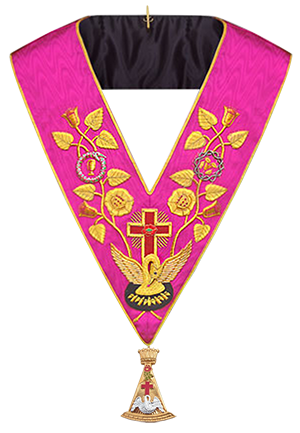
History
The Ancient and Accepted Rite derives from the Rite of Perfection, which developed in France mainly in the quarter-century before September 1762. Its constitution, and the rituals for its twenty-five degrees, were formalised by Francken in a manuscript bearing that date, though probably written somewhat later. It was followed by The Grand Constitutions of 1786, dated May 1786, which describe the Ancient and Accepted Rite, consisting of thirty-three degrees, largely as it exists today.
This document was presented as the product of a Council meeting under the titular direction of Frederick the Great. The original has not been found, and the copies seem to date from nearer to 1800.
In May 1801, in Charleston, the first Supreme Council following the Grand Constitutions was opened (now known as The Southern Jurisdiction of the USA).
It was followed by France (1804), Spain (1811) and the Northern Masonic Jurisdiction of the USA (1813). Ireland (1826) was the sixth, England and Wales (1845) -- receiving its Patent from the Northern Masonic Jurisdiction -- was the eleventh and Scotland (1846) the twelfth. There are now independent Supreme Councils in over 60 countries.
Regalia

The Regalia required, is the collar and jewel pictured above. The significance of the symbolism in the design of the collar and jewel is explained during the ceremony of perfection.
Dress worn is usually a dark suit, white collar and any dark tie, the exception being black, which is inappropriate for this Order. Higher degrees have their own specific collars and sashes.
Sussex District encompasses the whole of the County of Sussex and is headed by an Inspector General who is supported by a District Recorder. Their details are listed on this website and can be found in the Sussex Provincial Year Book.
Further information is available from the Chapter Recorders or from the District Recorder.
History
The Ancient and Accepted Rite derives from the Rite of Perfection, which developed in France mainly in the quarter-century before September 1762. Its constitution, and the rituals for its twenty-five degrees, were formalised by Francken in a manuscript bearing that date, though probably written somewhat later. It was followed by The Grand Constitutions of 1786, dated May 1786, which describe the Ancient and Accepted Rite, consisting of thirty-three degrees, largely as it exists today.
This document was presented as the product of a Council meeting under the titular direction of Frederick the Great. The original has not been found, and the copies seem to date from nearer to 1800.
In May 1801, in Charleston, the first Supreme Council following the Grand Constitutions was opened (now known as The Southern Jurisdiction of the USA).
It was followed by France (1804), Spain (1811) and the Northern Masonic Jurisdiction of the USA (1813). Ireland (1826) was the sixth, England and Wales (1845) -- receiving its Patent from the Northern Masonic Jurisdiction -- was the eleventh and Scotland (1846) the twelfth. There are now independent Supreme Councils in over 60 countries.
Regalia

The Regalia required, is the collar and jewel pictured above. The significance of the symbolism in the design of the collar and jewel is explained during the ceremony of perfection.
Dress worn is usually a dark suit, white collar and any dark tie, the exception being black, which is inappropriate for this Order. Higher degrees have their own specific collars and sashes.
Sussex District encompasses the whole of the County of Sussex and is headed by an Inspector General who is supported by a District Recorder. Their details are listed on this website and can be found in the Sussex Provincial Year Book.
Further information is available from the Chapter Recorders or from the District Recorder.